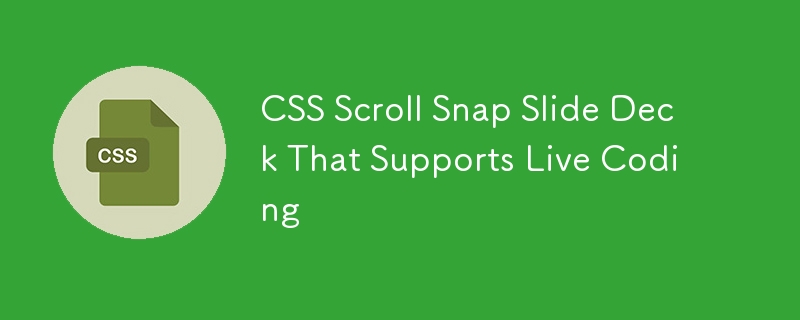This article demonstrates creating a responsive, shareable, JavaScript-free slide deck using CSS scroll snap, ideal for live coding presentations, even in a live venue. The tutorial builds a CodePen-based deck with editable CSS demos, focusing on efficiency and accessibility.

Virtual presentations have revolutionized content delivery, offering presenters flexibility with multiple monitors for off-screen adjustments during live coding. This tutorial bridges the gap between virtual and in-person events by creating a comparable experience using only web standards and modern CSS.
Key techniques explored include CSS scroll snap, counters, grid layout, the contenteditable attribute, custom properties, HSL theming, gradient text, and styling the <style></style> element. Three slide templates are developed: Text, Title, and Demo (a split layout for code and preview).
The HTML structure utilizes an ordered list (<ol></ol>) with the ID "slides," each list item (<li>) representing a slide with appropriate class modifiers (e.g., slide--text, slide--title, slide--demo). The contenteditable attribute enables live editing of CSS within the demo slides.
Base styles establish a consistent look and feel using custom properties (--theme-hue, --theme-saturation) for color theming with HSL. Gradient backgrounds enhance the title slides. The demo slide incorporates a resizable .style container housing an inline <style></style> element for live-editable CSS, and a .demo container for the preview. The contenteditable="true" attribute on the <style></style> element is crucial for the live-coding functionality. Note that browser compatibility varies; Firefox offers the most complete live-editing support.
Code highlighting is achieved using linear-gradients and -webkit-text-fill-color and -webkit-background-clip properties, with custom properties controlling highlighted lines. Utility classes (highlight--rule-only, highlight--none) provide additional highlighting control.
CSS scroll snap (scroll-snap-type, scroll-snap-align, scroll-snap-stop) enables smooth, one-slide-at-a-time navigation. A media query adapts the layout for smaller viewports, switching from horizontal to vertical scrolling. Slide numbers are implemented using CSS counters and data attributes for enhanced visual organization.
The final slide deck is fully responsive and adaptable to various screen sizes, offering a seamless presentation experience across different devices and browsers. While full syntax highlighting requires JavaScript, this approach prioritizes simplicity and accessibility. The tutorial concludes with a link to a completed example and additional resources for further exploration of CSS scroll snap.
The above is the detailed content of CSS Scroll Snap Slide Deck That Supports Live Coding. For more information, please follow other related articles on the PHP Chinese website!

Hot AI Tools

Undress AI Tool
Undress images for free

Undresser.AI Undress
AI-powered app for creating realistic nude photos

AI Clothes Remover
Online AI tool for removing clothes from photos.

Clothoff.io
AI clothes remover

Video Face Swap
Swap faces in any video effortlessly with our completely free AI face swap tool!

Hot Article

Hot Tools

Notepad++7.3.1
Easy-to-use and free code editor

SublimeText3 Chinese version
Chinese version, very easy to use

Zend Studio 13.0.1
Powerful PHP integrated development environment

Dreamweaver CS6
Visual web development tools

SublimeText3 Mac version
God-level code editing software (SublimeText3)

Hot Topics
 What is 'render-blocking CSS'?
Jun 24, 2025 am 12:42 AM
What is 'render-blocking CSS'?
Jun 24, 2025 am 12:42 AM
CSS blocks page rendering because browsers view inline and external CSS as key resources by default, especially with imported stylesheets, header large amounts of inline CSS, and unoptimized media query styles. 1. Extract critical CSS and embed it into HTML; 2. Delay loading non-critical CSS through JavaScript; 3. Use media attributes to optimize loading such as print styles; 4. Compress and merge CSS to reduce requests. It is recommended to use tools to extract key CSS, combine rel="preload" asynchronous loading, and use media delayed loading reasonably to avoid excessive splitting and complex script control.
 External vs. Internal CSS: What's the Best Approach?
Jun 20, 2025 am 12:45 AM
External vs. Internal CSS: What's the Best Approach?
Jun 20, 2025 am 12:45 AM
ThebestapproachforCSSdependsontheproject'sspecificneeds.Forlargerprojects,externalCSSisbetterduetomaintainabilityandreusability;forsmallerprojectsorsingle-pageapplications,internalCSSmightbemoresuitable.It'scrucialtobalanceprojectsize,performanceneed
 Does my CSS must be on lower case?
Jun 19, 2025 am 12:29 AM
Does my CSS must be on lower case?
Jun 19, 2025 am 12:29 AM
No,CSSdoesnothavetobeinlowercase.However,usinglowercaseisrecommendedfor:1)Consistencyandreadability,2)Avoidingerrorsinrelatedtechnologies,3)Potentialperformancebenefits,and4)Improvedcollaborationwithinteams.
 CSS Case Sensitivity: Understanding What Matters
Jun 20, 2025 am 12:09 AM
CSS Case Sensitivity: Understanding What Matters
Jun 20, 2025 am 12:09 AM
CSSismostlycase-insensitive,butURLsandfontfamilynamesarecase-sensitive.1)Propertiesandvalueslikecolor:red;arenotcase-sensitive.2)URLsmustmatchtheserver'scase,e.g.,/images/Logo.png.3)Fontfamilynameslike'OpenSans'mustbeexact.
 What is Autoprefixer and how does it work?
Jul 02, 2025 am 01:15 AM
What is Autoprefixer and how does it work?
Jul 02, 2025 am 01:15 AM
Autoprefixer is a tool that automatically adds vendor prefixes to CSS attributes based on the target browser scope. 1. It solves the problem of manually maintaining prefixes with errors; 2. Work through the PostCSS plug-in form, parse CSS, analyze attributes that need to be prefixed, and generate code according to configuration; 3. The usage steps include installing plug-ins, setting browserslist, and enabling them in the build process; 4. Notes include not manually adding prefixes, keeping configuration updates, prefixes not all attributes, and it is recommended to use them with the preprocessor.
 What are CSS counters?
Jun 19, 2025 am 12:34 AM
What are CSS counters?
Jun 19, 2025 am 12:34 AM
CSScounterscanautomaticallynumbersectionsandlists.1)Usecounter-resettoinitialize,counter-incrementtoincrease,andcounter()orcounters()todisplayvalues.2)CombinewithJavaScriptfordynamiccontenttoensureaccurateupdates.
 CSS: When Does Case Matter (and When Doesn't)?
Jun 19, 2025 am 12:27 AM
CSS: When Does Case Matter (and When Doesn't)?
Jun 19, 2025 am 12:27 AM
In CSS, selector and attribute names are case-sensitive, while values, named colors, URLs, and custom attributes are case-sensitive. 1. The selector and attribute names are case-insensitive, such as background-color and background-Color are the same. 2. The hexadecimal color in the value is case-sensitive, but the named color is case-sensitive, such as red and Red is invalid. 3. URLs are case sensitive and may cause file loading problems. 4. Custom properties (variables) are case sensitive, and you need to pay attention to the consistency of case when using them.
 What is the conic-gradient() function?
Jul 01, 2025 am 01:16 AM
What is the conic-gradient() function?
Jul 01, 2025 am 01:16 AM
Theconic-gradient()functioninCSScreatescirculargradientsthatrotatecolorstopsaroundacentralpoint.1.Itisidealforpiecharts,progressindicators,colorwheels,anddecorativebackgrounds.2.Itworksbydefiningcolorstopsatspecificangles,optionallystartingfromadefin






